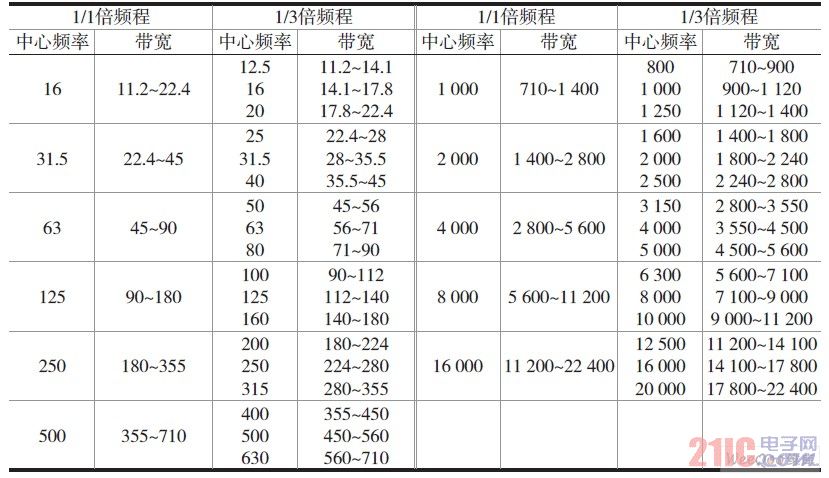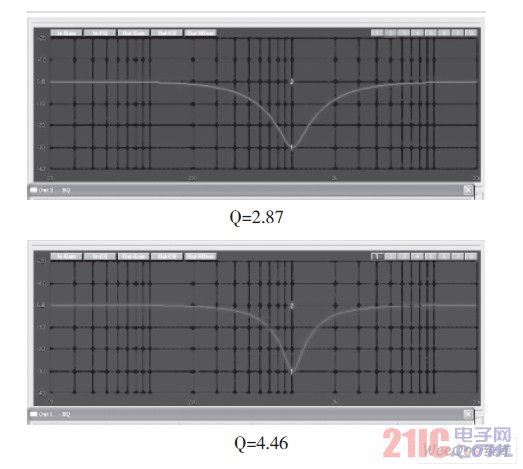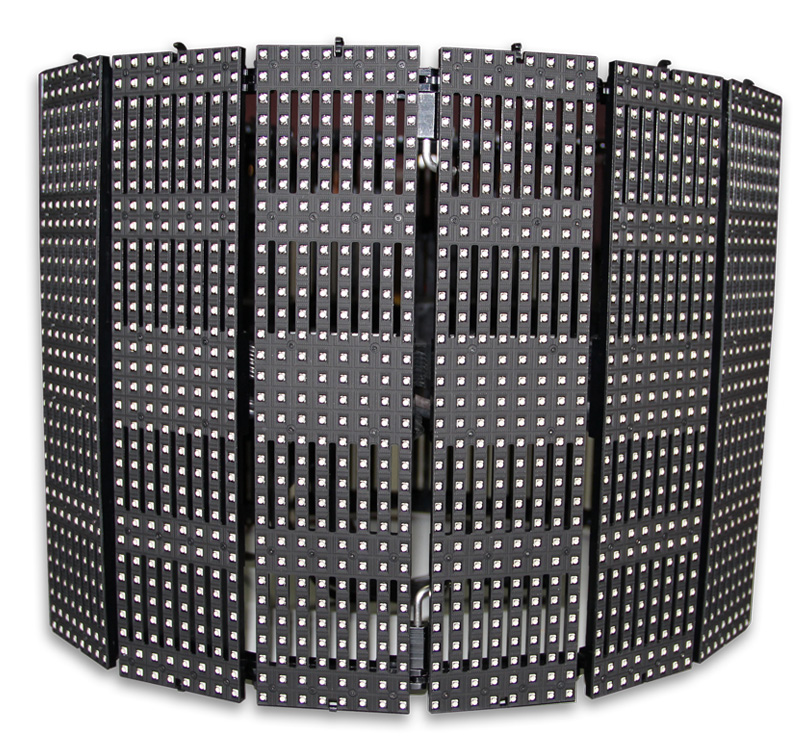The frequency of human ear listening ranges from 20 Hz to 20 kHz. It is impossible to measure each frequency in this range in acoustic measurement, but always take a specific value in a certain frequency interval, which is called a frequency band. The frequency band is determined by the upper limit frequency f 2 and the lower limit frequency f 1 , and f 2, f 1 is also referred to as a cutoff frequency. The interval between f 2 and f 1 can be expressed by the frequency ratio or the logarithm of base 2, which is called the frequency range. If the upper limit frequency in a frequency band is twice the lower limit frequency, the frequency bandwidth is said to be a octave band or an octave. This article refers to the address: http:// The general relationship between the upper and lower cutoff frequencies is f 2 = 2nf 1, then n = log2f 2 / f 1 = 3.32lgf 2 / f 1 where n is the coefficient of the octave, which may be a fraction or an integer. For example, n = 1/3 means 1/3 oct, and n =1 means 1 oct. It can be seen that when the frequency interval is evenly divided by the octave, the frequency is equivalent to the logarithm of the frequency. The center frequency fc of the frequency band is the geometric mean of the upper and lower cutoff frequencies, that is, fc=(f 2f 1) 1/2, which corresponds to the upper and lower cutoff frequencies of a certain center frequency is f 2=2n/2f c, f 1=2-n /2 fc If the center frequency and octave coefficient of a certain band are given, the upper and lower cutoff frequencies of this band can be calculated from the above equation. China has standardized the center frequency and bandwidth of 1/1 and 1/3 octave filters with reference to relevant international standards and the national standard “Common Frequencies in Acoustic Measurementsâ€, as shown in Table 1. Table 1 Common frequencies in acoustic measurements In addition, the parameter balance in the processor generally has three adjustment parameters, one is the center frequency (F), one is the bandwidth (BW or Q), and the other is the gain amount (GAIN). It is convenient and simple to adjust the frequency and gain. It is not easy to master the bandwidth. The equalizer is actually a filter. The bandwidth is the adjustment width of this filter, which is the size of the frequency adjustment range. Bandwidth (BW) can be used. Or the Q value indicates that the bandwidth value is in octave and the Q value is directly represented by a number. The larger the bandwidth data, the wider the adjustment range and the smaller the adjustment range. If the Q value is used, it is just the opposite. The larger the Q value, the sharper the filter and the smaller the adjustment range. When setting the equalizer, you will usually encounter Q. If the Q value is not set properly, it will affect the sound quality of the sound. The Q value is the quality factor of the filter, defined as the center frequency divided by the filter bandwidth. For example, the 31-band equalizer, according to the above table, the center frequency is 125 Hz. The frequency bandwidth is 112~140 Hz, 125 Hz. The Q value is: 125/(140-112) = 4.46. It can be inferred from the formula that the smaller the Q value, the larger the adjustable bandwidth, and the larger the Q value, the narrower the frequency band, as shown in Figure 1. Understanding the concept and calculation of octave and Q values ​​plays an important role in the use of the studio or outdoor sound equalizer and sound field debugging. There are two adjustment methods when using parametric equalization. (1) According to the listening effect of the acoustic environment in the scene, select a frequency yourself, then adjust the gain, listen to the sound effect of the scene, and then change the data size of the bandwidth or Q value, and try again until the scene is improved. sound effect. (2) If the frequency point cannot be determined, you can first set the bandwidth or Q value to 0.3 or 3. After the gain is 3~5 dB attenuation or boost, change the frequency (that is, sweep frequency) and finally find the appropriate frequency point. Then follow the above method to make a finer adjustment. If it is adjusted by means of the spectrum analyzer, according to the display of the spectrum, first find the peak point frequency of the peak or valley, then attenuate or boost it, and after the peak or valley of the spectrum display is gradually flattened, adjust the bandwidth to make the curve smoother. The coda crossover processor used now is divided into medium and high frequency and low frequency. For the middle and high frequency band or low frequency band setting and debugging, several center frequencies can be divided, and then the gain and Q value of the frequency are adjusted until the sound field sounds good. When a certain frequency is very prominent and sounds uncomfortable, it is often chosen that the Q value of a certain frequency is large, and the frequency band is attenuated or increased. The most important thing is that the selection of the Q value or the center frequency is carefully listened to by the ear. Until it feels good.
Product description
Specifications:
1. Flexible and bendable
2. Super thin
3. Supe small weight
4. Easy to assemble, install and maintain
5. Display: shows the small spacing, viewing distance closer; the country star gold and copper support high quality surface mount lamp, horizontal and vertical angle of 130 degrees, light mixing uniformity, color matching degree is high, good consistency, clearer display true, fully meet the needs of outdoor display;
6. Energy consumption: a positive response to the national policy of energy saving by 4.5, switching power supply, power consumption can save 10%;
7. Structure: the bottom shell adopts the reinforcing rib design of quasi construction engineering mechanics, enhance the bearing tensile ability of products and improve the overall smoothness of the mask; the calculation precision with stripe design, greatly reducing the environmental problems due to light reflection on the interference caused by the lamp light, ensure contrast products in a variety of ambient light the degree is the best, the whole screen is more black ink, better contrast, more realistic image color reduction.
8. Circuit: high performance "wig" program for PCB layout design, can effectively control the voltage peak overshoot, the maximum extension of the tube, chips and other components of the life; with power supply, general signal interface, not affected by any geographical and environment control system and other factors, for to be able to easily display various types of connection and installation and operation.
9. Protection: the positive use of special conductive silicone encapsulant, on the back of three spraying paint protection, double waterproof protection, making the product more weatherability, heat faster; the drainage hole of the unique design, reduce the water causes damage to the module module due to defects of steel structure, improve the module of self-protection, further to protect the life of display screen.
10. Use: compared to outdoor full color products, outdoor SMD S series products lighter, for maintenance, assembly, transport and later brought convenient and time-saving.
Flexible Curtain Style Arc Led Display Rgb Led Display,Flexible Led Curtain Display,Flexible Led Display Screen,Flexible Curtain Style Arc Led Display Shenzhen Joy LED Display Co., Ltd. , http://www.joe-led.com
It can be seen from Table 1 that 1/3 octave is to insert two frequencies between two frequencies separated by 1/1 octave, so that these four frequencies are sequentially called 21/3 times, these four frequencies. The ratio is 1: 21/3: 22/3: 2. 
Figure 1 Q value impact on bandwidth
